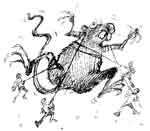Stalking plague
 it is heartening to note that in the present decade, the intellectuals and academicians of the nation are not pontificating and publishing in just the realm of abstract theory but are directly linking their expertise and studies to the very real situations and problems faced by people.
it is heartening to note that in the present decade, the intellectuals and academicians of the nation are not pontificating and publishing in just the realm of abstract theory but are directly linking their expertise and studies to the very real situations and problems faced by people.
Ghanshyam Shah is director of the Centre for Social Studies, Surat, Gujarat, and hence was the appropriate person to make a political-anthropological study of the epidemic that spread through Surat and rocked the entire world. This book examines the epidemic (widely believed to be pneumonic plague) in Surat in the context of much larger and fundamental issues like character of urban development in India, state of the public health system, the state of municipal services, socio-economic background of affected people, state's response to such emergencies, and social action or the lack of it.
Ghanshyam Shah has convincingly argued that "plague is not merely a biological disease. It is the symptom of
• unplanned growth that disturbs the ecology and the environment and,
• uneven distribution of resources that weakens the social fabric.
He has pointed out how a more or less complete collapse of the political system and public health system led to the outbreak of the epidemic. And the vital though still unanswered question raised in the book is despite a near consensus among all sections of society on the root causes of these problem, why is effective social consciousness and action not emerging?
The author has studied the pattern of urban growth, social setting, haphazard industrialisation, and settlement which led to social decay and made the climate conducive for communal violence of 1992-93 and the plague of 1994.
Surat is one of the fastest growing cities of the country with a three-fold increase in population between 1971 and 1991. Industrial pollution, population congestion, inadequate supply of potable water, inefficient and inadequate public health facilities have all contributed to frequent outbreak of endemic diseases like malaria, gastroenteritis, pneumonia and diarrhoea.
In an interesting chapter on public perception and response, the book traces how various sections of society reacted differently, except of course the immediate reaction of panic. Rumours flew thick and fast, often acquiring communal overtones. Thirty per cent of the city's population fled. Not only this, 70 per cent of the doctors fled. Of those who remained, only a few attended to their duties.
The chapter which deals with crisis management describes how the government's credibility touched an all-time low and its inability to tackle the situation was brutally exposed. Early signals and various studies had warned of the possibility of epidemics but these were ignored. The plague surveillance centre had been functioning only in name.
The author has called for a holistic approach to the economy and health instead of the fragmentary approach of the present. The health system ought to be prevention-based rather than cure-oriented. Better municipal services, nutrition, slum management and scientific research are also called for.
This is a book entirely for the people. It was referred to by the Surat Municipal Corporation in drawing up its action plan for the improvement of the city. The positive fallout is that Surat today in the second cleanest city of the country.
